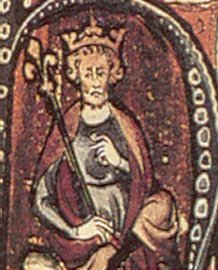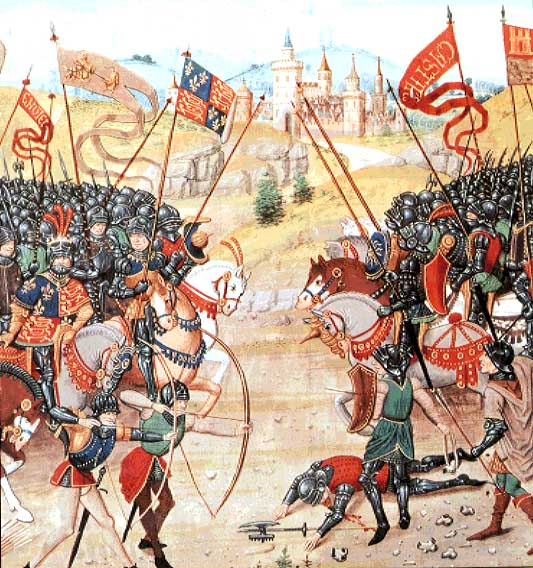The Reigns of Edmund Ironsides and the Danish Kings.
The Rule of Edmund Ironsides
Edmund came to the throne after the death of his father by illness. The situation of England at the time was very dire, to say the least. Knud was, by this time, besieging London itself. Edmund was determined to mount a last ditch effort to save England from Knud. He did this by first abandoning London for the time being and heading to Wessex to raise an army. The Danish army pursued Edmund to Wessex but by the time they got there Edmund had raised his army and then in a series of battles he fought the Danes to a standstill in northern Wessex. Once they were at a stand still the Danes went back to London to siege it again only to be attacked by Edmund and beaten back. Edmund was then able to win a string of important victories against Knud and it looked as if he may end up beating Knud back to Denmark and freeing his country.
This, however, was not to be. On October 18 1016 Knud soundly beat him in the Battle of Ashingdon in modern Essex. After this battle Edmund and Knud sat down to discuss a peace. This peace was in Knud's favor due to the victories Knud had over Æþelræd Unræd and the victory of Ashingdon. The peace did, however, recognize the victories Edmund inflicted on Knud's army. The treaty ended up leaving Edmund in control of all land south of the Themes and when Knud or Edmund died the other would receive the land of the first. A month and a half later Edmund died, it is said that some of Knud's men hid under a lavatory and thrust a sword into Edmund as he sat down on the lavatory.
The Rule of Knud den Store
Knud ascended to the throne on Christmas day 1016 with nobles recognizing him as king in January. One of his first acts was to marry Emma of Normandy, the widow of Edmund Ironsides. This is assumed to place legitimacy to his claim and to remove Norman enemies, among those were the sons of Edmund and Emma. Through his reign, Canute brought together English and Danish customs, and the English saw a golden age of cooperation with Scandinavia, as well as true dominance in the British Isles. His mutilation of the hostages at Sandwich is ultimately seen to be uncharacteristic of his reign. He reinstated the Laws of King Edgar to allow for the constitution of a Danelaw, and the activity of Scandinavians at large. He also reinstituted the extant laws with a series of proclamations to assuage common grievances brought to his attention. Two significant ones were: On Inheritance in case of Intestacy, and, On Heriots and Reliefs. He strengthened the currency, initiating a series of coins of equal weight to those being used in Denmark and other parts of Scandinavia. This meant the markets grew, and the economy of England was able to spread itself, as well as widen the scope of goods to be bought and sold.
Canute was generally thought to be a wise and successful king of England, although this view may in part be attributable to his good treatment of the Church, keeper of the historic record. Either way, he brought decades of peace and prosperity to England. His numerous campaigns abroad meant the tables of Viking supremacy were stacked in favor of the English, turning the prows of the long ships towards Scandinavia. The medieval Church was adept to success, and put itself at the back of any strong and efficient sovereign, if the circumstances were right for it. Thus we hear of him, even today, as a religious man, despite the fact that he was in an effectively sinful relationship, with two wives, and the executions of his fellow Christian political opponents. Canute was ruler across a domain beyond any monarchs of England, until the adventures of the imperial European colonies, and the empire of the English.
On his death in 1035 his son Harold Harefoot ascended to the throne.
The Rule of Harold Harefoot
Harold's younger half-brother Hardeknud, the son of Canute and his queen, Emma of Normandy, was legitimate heir to the thrones of both the Danes and the English. He was, however, unable to travel to his coronation, because his Danish kingdom was under threat of invasion by King Magnus I of Norway and King Anund Jacob of Sweden. England's magnates favored the idea of installing Harold Harefoot temporarily as regent, due to the difficulty of Hardeknud's absence, and despite the opposition of Godwin, the Earl of Wessex, and the Queen, he eventually wore the crown.
Harold survived an attempt to unseat him led by his half-brothers Alfred Aetheling and Edward the Confessor, Emma's sons by the long-dead Ethelred the Unready, in 1036. Harold died at Oxford on March 17, 1040, just as Hardeknud was preparing an invasion force of Danes, and was buried at the abbey of Westminster. His body was subsequently exhumed, beheaded, and thrown into a fen bordering the Thames when Hardeknud assumed the throne in June, 1040. His supporters later rescued the body, to be buried in a church which was fittingly named St Clement Danes.
The Rule of Hardeknud
Hardeknud, or Canute the Hardy, ruled England for two years after the death of his half brother Harold Harefoot. Hardeknud was a harsh and unpopular ruler: to pay for his fleet, he severely increased the rate of taxation, and in 1041 the people of Worcester killed two of Hardeknud's housecarls who had been collecting the tax, prompting an attack by Hardeknud in which the city was burned. The story of Lady Godiva riding naked through the streets of Coventry to persuade the local earl to lower taxes may come from the reign of Hardeknud. The Anglo-Saxon Chronicle gives a dismal assessment of him: "He never accomplished anything kingly for as long as he ruled." It also says that in 1041 Hardeknud broke a pledge and betrayed Earl Eadwulf of Northumbria, who was under his safe conduct.
In 1041, Hardeknud invited his half-brother Edward the Confessor (his mother Emma's son by Ethelred the Unready) back from exile in Normandy to become a member of his household, and probably made Edward his heir. Hardeknud was unmarried and had no known children. It is rumored he fathered an illegitimate son, William Canute. On June 8, 1042, he died at Lambeth — he is said to have died as he stood at his drink, and he suddenly fell to the earth with an awful convulsion; and those who were close by took hold of him, and he spoke no word afterwards. He was buried at Winchester, his father's place of rest, and his mother's, on her death. Edward assumed the throne on Hardeknud's death, restoring the Saxon royal line of Wessex.
Note about Leofric and Godwin
It should be noted that Leofric was appointed as the Earl of Murcia, at the start of the reign of Knud. It is also said that his wife, during the reign of Hardeknud, rode naked through the town of Coventry to protest the oppressive tax of the town by Hardeknud. She is known as Lady Godiva and her legend is most famous for the voyeur by the name of Tom from which we get the saying "peeping Tom". Leofric is the father of Leofricson, who founded the House of Leofricson.
Godwin, the father of Godwinson, was appointed the Earl of Wessex by Knud at the same time as Leofric became the Earl of Murcia. Godwinson is the founder of the House of Godwinson.










